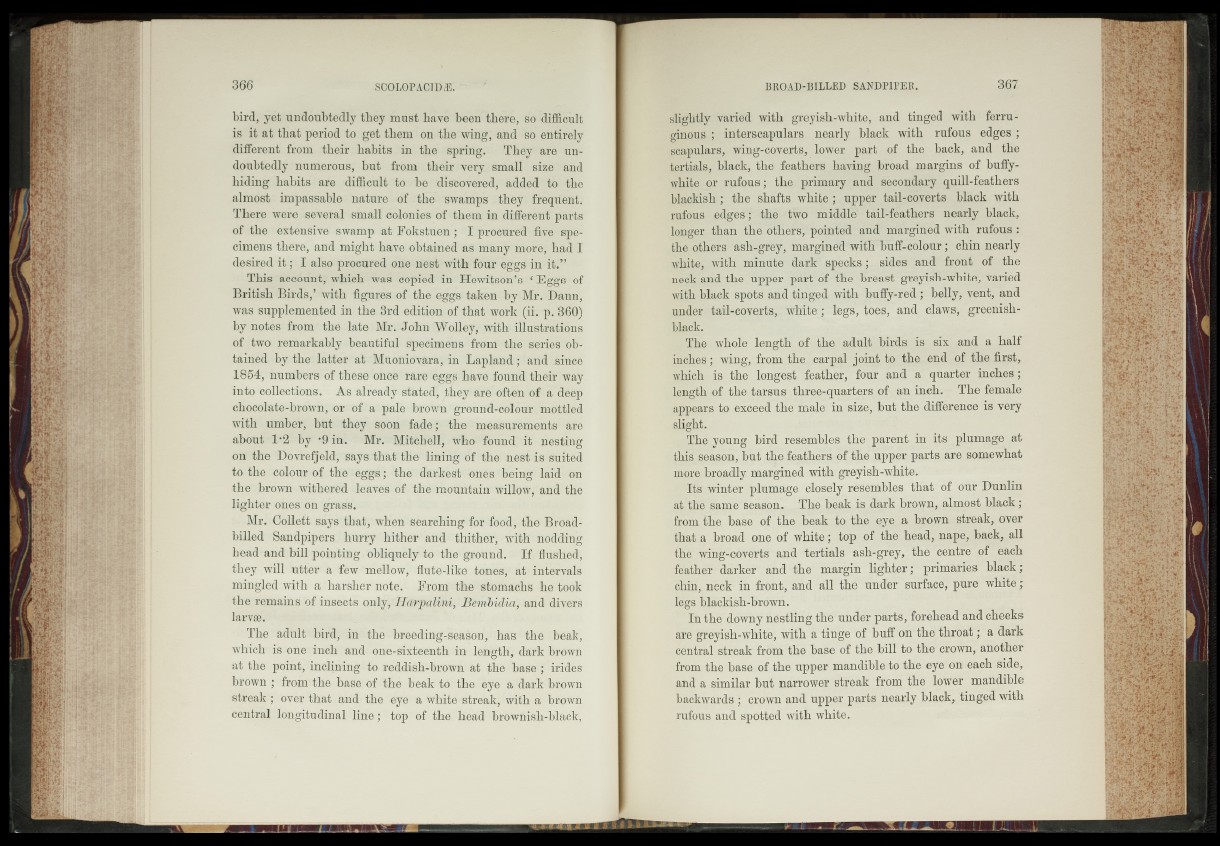
bird, yet undoubtedly they must bavé been there, se difficult
is it at that period to get them on the Wing, and so entirely
different from their habits in the spring. They are undoubtedly
numerous, but from their very small size and
hiding habits are difficult to be discovered, added-to the
almost impassable nature óf -the swamps . they frequent.
There were several small colonies of them in different parts
of the extensive swamp at Fokstuen ; I procured five specimens
there, and might have obtained as many more, had I
desired ik; I also procured one nest with four eggs-in it}*'’ f
This account; which was copied ini Sêwifson’s ‘ Eggs of
British Birds,’ with figures of the eggs taken by Mr. Dann,
was supplemented in the 3rd edition of that work p. 360)
by notés from the late Mr.'.ffôte'^olteyÿ with illustrations
sof ?two remarkably beautiful specimens from the sori^TObtained
by the latter at Muoniotara, in Lapland; -and since
1854, numbers of these once rare egM have found their'way
into collections. As already stated^ jtneÿ'are ©ffeen*öf a deep
chocolate-brown, or'of-a pale -brown- ground-colour’, mottled
with umber, but they soon fade ; j the measurement^®©
about l*r2 by *9'in. Mr. M'ittohelf, who®f6und>i%;- néstkfg
on the Bovre^eld,'says thnf-the' lining of ythe~nëst4s-:Su4téd
to the colour Of theiêggi; -the (Éirkêst-ones he-ingp laid- on
th e . brown withered leaves Of thesmountain willow, and the
lighter oites oh grass.
■ - Mr* Collect Says that', when searching'for fo¥dp4hè Broad-
billed Sandpipers, hurry hither and thither, with nodding
headland bill pointing.rébliquefy%;dfié%round. I f fiU&Kedj
they will utter a few "mellow, flftMik-ér tones; aftdnfevals
mingled1.with a harsher' note>- Erom*-the ^sfomtichs he took
the remain¥~o£ insects otélgfHcür'pa Uni, ’Bembidiafi&n^dêiïëiè
larvse. •
- % The adult1 bird, in the "’feéèding-ieÊson-f has thé -beàk,
which'î is one inch and ohe-efstëehth’stn length; dhfk
at the point, -inclining to reddish-brown-at thé' bâse-'f-drides
brown ; from'the base of the beak to^the «èyé a dark'-bfèwù
streak; over that, and-thé iyérra 'white-strefcl%%ith aNbfown
centra^ longitudinal line;*'tóp' of the, head brownish-black,
slightly varied, with greyish *wbite, and tinged with ferruginous
; interscapulars nearly black with rufous edges ;
scapulars, wing-coverts, lower part of the back, and the
tertials, black, the feathers having broad t margins of buffy-
white^or rufous; the primary and secondary quill-feathers
blackish ; the shafts white; upper ^tail-inverts black with
rufous, edges-; the - two middle - tail-feathers nearly black,
longer than thé ötÉefsf pointed and''margined with rufous :
the others ash-grey, margined with~buff-colour; chin nearly
white, with minute darkr specks; sides and front of ..the
neck and the 'upper part of the-breast greyish-white,* varied
wj|Jr black spots and tinged with buffy-red § belly, vent, and
under- tail-coverts^-whiter; ‘tegs,' toes, and claws, greenish-
black.
The whole length of the adult birds is six" and a half
inches; wing, from the carpal joint to the end of the first,
which is the longest feather," four and a quarter inches;
length of the; tarsus three-quarters of -an inch. - The female
.appears to exceed the male in size, but the difference is very
slight.
The young bird resembles, the narent in its plumage at
this. |caspu) but the feathers of the upper parts are somewhat
more,-broadly margined with'greyish-whit©:^*
Its» winter plumage- -'clo’èeïy resembles^ffiat^cf Öur Dunlin
at the same season.^, Thp bea^fe^ark jjrown, almost black;
.yjiphihe base of the,, beak to- the eye a brown streak, over
that a broad one of white; top of the head, nape, back, all
thB' Wing-covë'rts and tertials aslPgrey,' the ^centre' oi each
f&thêr* darker and the margin lighter; primariés black;
chinneck- in front, and all the under surface, pure wMtie;
legs blackish-brown. *
In thé dWny nëstling the under parts, forehead and cheekë
are- greyish-white; with a tinge ¥f buff on the throat; a dark
central streak from the base" of Me bill5 to- the'crown; anotfiér
from the basosof the upper mandiblerto the eye on each side,
and a,similar but narrower-streak from the lower mandible
;|||4kwards ; crown and upper parts nearly black, tinged with
rufous and spotted with white.